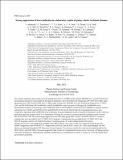Strong suppression of heat conduction in a laboratory replica of galaxy-cluster turbulent plasmas
Author(s)
Meinecke, J.; Tzeferacos, P.; Ross, J.S.; Bott, A.F.A.; Feister, S.; Park, H.-S.; Bell, A.R.; Blandford, R.; Berger, R.L.; Bingham, R.; Casner, A.; Chen, L.E.; Foster, J.; Froula, D.H.; Goyon, C.; Kalantar, D.; Koenig, M.; Lahmann, Brandon; Li, Chi-Kang; Lu, Y.; Palmer, C.A.J.; Petrasso, Richard D.; Poole, H.; Remington, B.; Reville, B.; Reyes, A.; Rigby, A.; Ryu, D.; Swadling, G.; Zylstra, A.; Miniati, F.; Sarkar, S.; Schekochihin, A.A.; Lamb, D.Q.; Gregori, G.; ... Show more Show less
Download21ja109_full.pdf (8.377Mb)
Metadata
Show full item recordAbstract
In conventional gases and plasmas, it is known that heat fluxes are proportional to temperature gradients, with collisions between particles mediating energy flow from hotter to colder regions and the coefficient of thermal conduction given by Spitzer’s theory. However, this theory breaks down in magnetized, turbulent, weakly colli- sional plasmas, although modifications are difficult to predict from first principles due to the complex, multiscale nature of the problem. Understanding heat transport is important in astrophysical plasmas such as those in gal- axy clusters, where observed temperature profiles are explicable only in the presence of a strong suppression of heat conduction compared to Spitzer’s theory. To address this problem, we have created a replica of such a sys- tem in a laser laboratory experiment. Our data show a reduction of heat transport by two orders of magnitude or more, leading to large temperature variations on small spatial scales (as is seen in cluster plasmas).
Description
Submitted for publication in Science Advances
Date issued
2021-05Department
Massachusetts Institute of Technology. Plasma Science and Fusion CenterJournal
Science Advances
Publisher
Science
Other identifiers
21ja109